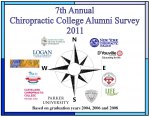Chiropractic Colleges Not Preparing Graduates for Business Aspects of Practice

An ongoing survey of chiropractic college alumni reveals that graduates do not feel prepared for business or practice management and chiropractic college alumni are also reporting a decrease in net income since 2004 when the survey first began.
The survey, conducted by New York Chiropractic College is conducted annually and includes alumni responses from the following chiropractic institutions:
- Northwestern Health Sciences University
- Logan College of Chiropractic
- Life West
- Southern California University of health Sciences
- Cleveland Chiropractic College
- Parker UniversityTexas College of Chiropractic
- Life University
- Sherman College of Chiropractic
- D’Youville College
- New York Chiropractic College
The 2011 report, which includes data from 2004, 2006 and 2008, shows that when asked to rate their preparedness for business and practice management on a 5 point scale with one being “NOT PREPARED” and 5 being “WELL PREPARED” alumni gave an overall rating of 2.02. Further, this has not changed substantially since 2004 when alumni rated this category as a 1.95.
Interestingly, the survey also reveals a decrease in net income among the respondents since 2004 when chiropractic college alumni reported a range of $75,000.00 to $89,000.00. The 2008 data reports net income in the $45,000.00 to $59,000.00 range.
The focus on income and business preparedness for chiropractors has recently heightened as the profession becomes increasingly scrutinized from both within and outside its ranks. Internal divisions within the profession have existed since its founding but seem to have reached a peak with recent efforts among the controlling factions to incorporate prescribing privileges along with the continued metamorphosis of its educational standards towards the training of primary care physicians.
These tactics are seen as part of broader acts of desperation by the profession’s leaders to deal with declining market share for chiropractic specific services, decreasing insurance reimbursement, and declining enrollment in chiropractic colleges.
The efforts to add drugs and position chiropractors as primary care physicians have recently been stymied by efforts among the traditional, conservative faction of the profession that seeks to keep the profession’s scope of practice focused on the spine and nervous system.
These internal battles have become public as the more medically oriented and traditional factions come to blows over these changes. Most significantly they have played out at the level of the Federal Government via the National Advisory Committee on Institutional Quality and Integrity (NACIQI) which regulates accrediting agencies. While accreditation battles within chiropractic have raged for decades they have increased since 2006 when NACIQI labeled the more medically oriented faction of the profession a “Cartel” and stated they had a “monopoly” on chiropractic education. Recent hearings before NACIQI in December 2011 drew over 4000 complaints from chiropractors and their supporters against the Council on Chiropractic Education (CCE) which is the sole accreditor for chiropractic educational programs. NACIQI found the CCE to be in violation of 43 Federal Recognition Criteria and the CCE has until Spring of 2013 to respond to these concerns.
One of the concerns that has arisen within the profession is the value of the 6-8 year chiropractic training program that can end up saddling graduates with over $200,000.00 in student loan debt. In a recent article on the crisis in chiropractic education, Dr. Christopher Kent, President of the Foundation for Vertebral Subluxation wrote on the reasons for the crisis which he says stems:
“. . . in part, from the high cost of chiropractic education. Many DCs graduate with a debt burden that may exceed $200,000. This graduate is faced with limited income potential as an associate, or the additional cost of purchasing or establishing a private practice. Opportunities in education and research are limited, and may require additional education.”
Kent urges his colleagues to address the elephant in the room and revamp chiropractic education. Others have suggested this as well and one wonders how long it will take the schools to address a problem regarding training in the business aspects of practice that they have known about since at least 2004.
Blogs
- The Chiropractic Cartel: A Look Back at Bias in Accreditation and its Imact on Today's Profession
- Inside Montana's Chiropractic Monopoly: ACA & MCA's Brazen Board Takeover
- Concerns Grow About Control of the NY State Chiropractic Board by the ACA - Use of X-ray in NY Under Threat
- Reproductive Health Information and Chiropractic Care: Navigating New Privacy Regulations
- Navigating Substance Use Disorder (SUD) Consent: What Chiropractors Need to Know














